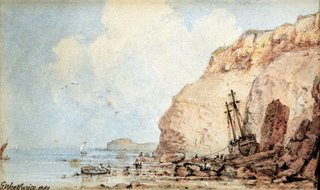See the Collina's position in Google Maps Her owner William Read of Ipswich was accused of inciting her master William Simpson to sink her. The report of Read and Simpson's trial was recoded in the Nautical Magazine in 1844 -
'John Brady, examined by Mr. C. Jones: I am a mariner, residing in Barking, in Essex. My business is the Cod fishing. In the month of June, 1841, I had the command of a smack called the Sarah, and I went in her to the coast of Holland. I was off that coast in company with some other smacks. I was lying off the Brown Bank on the eastern edge. There were about eight other smacks lying off the same place. About six o'clock one morning I was roused out of my berth by the watch, and I immediately went on deck, and my attention was directed to a brig which was in sight. This brig I afterwards found at to be the Colina. She was about six miles off, and appeared to have been deserted by her crew, and to be in distress. Her canvas was only three parts set, and there was no signal of distress hoisted. The wind at that time was south-west, and the weather fine. I called all hands and made towards the ship. I neared her very soon, and was about half a mile distant when she went down. I then took up the crew who were in the long-boat. They had been taken on board a Dutch galliot, which they left to come on board of my vessel.'
In The Proceedings of the Old Bailey, 1674-1913 it is recorded: WILLIAM SIMPSON was indicted for feloniously and maliciously casting away and destroying a vessel called the Colina, with intent to defraud John Irving and others; to which he pleaded. GUILTY . Aged 28.— Transported for Life. Before Mr. Baron Gurney.


